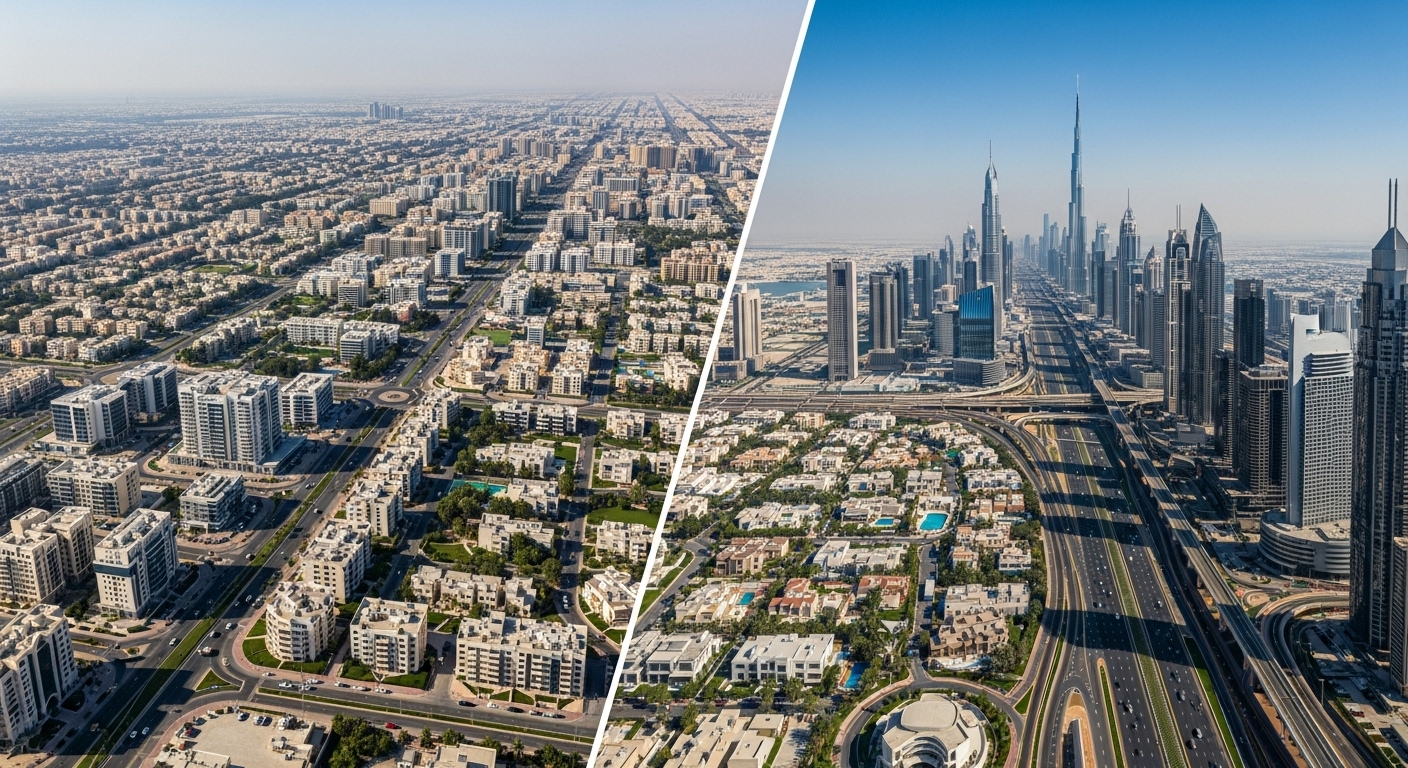The property market in the UAE has always had its fair share of frenzy as most bids center around Dubai. With its glitzy skyline, flourishing infrastructure, and world-class lifestyle, this is only fair. But what if we were to tell you that a real estate underdog is rising next door? Sharjah, quietly cheaper, is beginning to signal smart investors and first-time buyers.
Let us go in-depth into the unexpected showdown between Sharjah and Dubai and see which emirate will actually stretch your dollar more going into 2025.
Comparing Property Prices: Sharjah vs Dubai:
Dubai:
Dubai’s property market is known for its premium appeal. In 2025, average apartment prices in prime areas like Downtown Dubai or Dubai Marina hover between AED 1,500 and AED 2,500 per sq. ft. The villas in locations like Palm Jumeirah and Emirates Hills could well exceed AED 10 million.
Even in emerging communities like Jumeirah Village Circle or Dubailand, average rates remain at AED 900 and AED 1,200 per sq. ft., making it hard for any budget buyer to enter.
Sharjah:
On the contrary, Sharjah provides a much more budget-friendly alternative. Apartment prices can range from AED 450 to AED 750 per sq. ft. depending on location. Spacious 2-3 bedroom flats in places like Al Nahda or Muwaileh can be purchased for under AED 700,000.
Villas in family-friendly locations like Aljada or Tilal City start from AED 1.2 million, therefore making it very easy to enter the ownership way.
Key Takeaway:
For the price of a studio in Business Bay, you could potentially own a 2BHK in Sharjah with extra budget for furnishing.
Cost of Living: What You Don’t See on the Property Listings:
The price of property is only part of the big picture. The day-to-day cost of living plays a big part when it comes to making a decision on where to live.
- Utilities & Maintenance: In Sharjah, the lesser service charges and energy costs help lessen the monthly bill considerably.
- Transport: Increasingly, more residents are commuting from Sharjah to Dubai, so all sorts of modes of public transport and ride-share options have opened up. Fuel price-wise nothing has changed much but short-distance trips further within Sharjah lessen one’s ultimate daily expenditure.
- Education & Groceries: Cost-effective schooling and hypermarket options allow families to save on average 25% every month compared to living in Dubai.
Bottom Line:
For those straddling the balance between expenses, Sharjah is thereby offering a more sustainable lifestyle, especially for families and working professionals.
Rental Yield & Investment Opportunities:
The Dubai rental yields hovering around 6-8% per annum in areas such as JLT and Dubai South remain attractive, especially for those using short-term rentals and Airbnb-style bookings.
Sharjah, on the other hand, is proving to be a high-yield sleeper. Rental returns are between 7-9% in communities such as Al Nahda, Aljada, and Muwaileh, spurred by the increasing number of residents commuting for work to Dubai but living in Sharjah.
It also adds:
- Increasing demand from expatriates
- New off-plan projects with post-handover payment plans
- Less stringent down payment structures
Sharjah is fast becoming a buy-to-let perfect market, especially for long-term rentals focused on affordability.
Quality of Life & Community Development:
Dubai is top-notch when it comes to modern communities, but Sharjah is fast catching up.
Highlighting Sharjah:
- Aljada by Arada: a master-planned city with smart villas, retail avenues, and schools
- Tilal City & Masaar: Villa communities with green zones and family parks surrounding them
- Development of more schools, medical centers and malls aimed at long-term livability
Highlighting Dubai:
- Iconic lifestyle hubs like Dubai Hills Estate and Bluewaters Island
- Smart city innovations in District 2020 and MBR City
- Amazing F&B, leisure, and wellness infrastructure
Verdict:
If you’re chasing luxury and global-standard amenities, Dubai still wins. However, if your criteria point toward comfortable family living at half the cost, newer communities in Sharjah are, indeed, great alternatives.
Connectivity & Daily Commute:
Shares are held in significant correspondence with the commuters of Sharjah, but that is changing fast.
Modern Developments Improving Commute:
- Sharjah-Dubai Metro Line (announced, planning stage)
- Etihad Rail Project: Connecting northern emirates to Dubai and Abu Dhabi
- Road Upgrades: Major expansions on Emirates Road and Sheikh Mohammed Bin Zayed Road
Current Travel Time:
- Al Nahda (Sharjah) to Downtown Dubai: 30-45 minutes during off-peak
- Newer communities closer to the border (like Al Mamsha) are even faster
Takeaway:
The commute is no longer a deal-breaker-clearly if you work in Dubai South, Deira, or Business Bay.
Sharjah or Dubai – Where Should You Invest in 2025?
It all comes down to your goals.
| Goal | Recommended Emirate |
|---|---|
| First-Time Home Buyer | Sharjah |
| High ROI on Rentals | Sharjah |
| Luxury Lifestyle & Status | Dubai |
| Short-Term Flipping | Dubai |
| Long-Term Family Living | Sharjah |
But this is where things get interesting-and not how you might expected
If you’re looking for property as not just an asset investment, but as a vehicle for residence in the UAE, Dubai will probably still have the edge in 2025.
The UAE government has just made another very important announcement.
👉🏼 Golden Visa 2025 Update: Buy Property of AED 2M, Get Residency Instantly
So if you’ve got AED 2 million or so to invest, the Dubai properties not only have a firm premium value base but also might get you 10-year residency benefits, including business ownership rights and family sponsorship.
Sharjah is the affordable quality live option. But for those who want higher benefits in property and immigration, the AED 2M threshold in the Golden Visa might even lend the scales to Dubai.
Make wise choices: In 2025, the UAE will sell not only property but opportunities.

